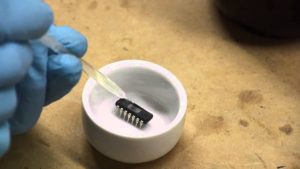Crack ATmel MCU AT32UC3C264C Program
Crack ATmel MCU AT32UC3C264C Program start from unlock its tamper resistance system and read the heximal out from it, please view the ATMEL MCU AT32UC3C264C features for your reference:
One 4-Channel 20-bit Pulse Width Modulation Controller (PWM)
– Complementary outputs, with Dead Time Insertion
– Output Override and Fault Protection
One 16-channel 12-bit Pipelined Analog-To-Digital Converter (ADC)
– Dual Sample and Hold Capability Allowing 2 Synchronous Conversions
– Single-Ended and Differential Channels, Window Function
Two 12-bit Digital-To-Analog Converters (DAC), with Dual Output Sample System
Four Analog Comparators
Six 16-bit Timer/Counter (TC) Channels
– External Clock Inputs, PWM, Capture and Various Counting Capabilities
One Peripheral Event Controller
– Trigger Actions in Peripherals Depending on Events Generated from Peripherals or from Input Pins
– Deterministic Trigger after atmel mcu being cracked
– 34 Events and 22 Event Actions
Five Universal Synchronous/Asynchronous Receiver/Transmitters (USART)
– Independent Baudrate Generator, Support for SPI, LIN, IrDA and ISO7816 interfaces
– Support for Hardware Handshaking, RS485 Interfaces and Modem Line
Two Master/Slave Serial Peripheral Interfaces (SPI) with Chip Select Signals
One Inter-IC Sound (I2S) Controller
– Compliant with I2S Bus Specification
– Time Division Multiplexed mode
Three Master and Three Slave Two-Wire Interfaces (TWI), 400kbit/s I2C-compatible
QTouch® Library Support
– Capacitive Touch Buttons, Sliders, and Wheels
– QTouch® and QMatrix® Acquisition
On-Chip Non-intrusive Debug System
– Nexus Class 2+, Runtime Control, Non-Intrusive Data and Program Trace
– aWire™ single-pin programming trace and debug interface muxed with reset pin
– NanoTrace™ provides trace capabilities through JTAG or aWire interface
3 package options
– 64-pin QFN/TQFP (45 GPIO pins)
– 100-pin TQFP (81 GPIO pins)
– 144-pin LQFP (123 GPIO pins)
Two operating voltage ranges:
– Single 5V Power Supply
– Single 3.3V Power Supply after Crack MCU
Tags: crack atmel mcu binary,crack atmel mcu code,crack atmel mcu data,crack atmel mcu eeprom,crack atmel mcu file,crack atmel mcu firmware,crack atmel mcu heximal,crack atmel mcu memory,crack atmel mcu program


